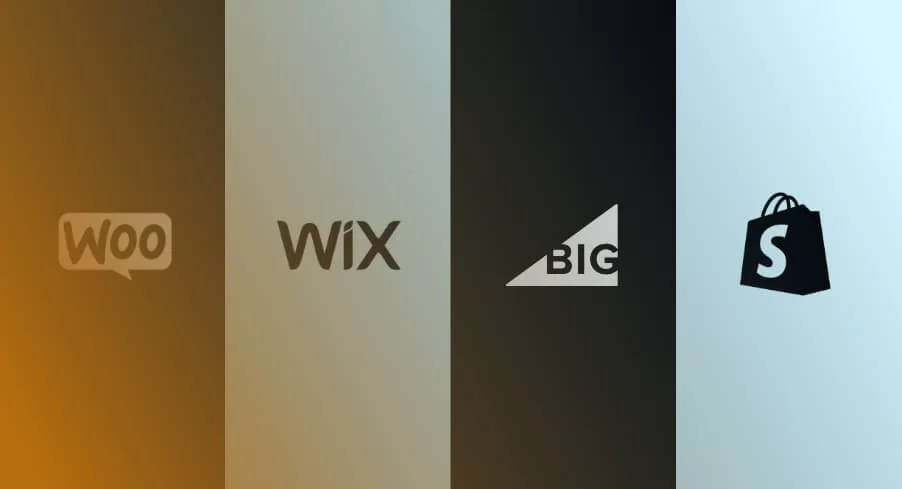TABLE OF CONTENTS
Add a header to begin generating the table of contents

Running an online store is a big undertaking.
eCommerce store owners constantly face challenges with existing online store setup and management. The common complaints we hear are:
- I have thousands of products, but my shopping cart keeps crashing or slowing down.
- Managing my store feels like a chore. I’m juggling too many plugins just to get basic things done.
- The backend is a nightmare. Adding new products with variations takes forever.
- Constant security and software updates are eating my time.
- Limited platform features or customization options.
Sounds familiar?
So, if you are frustrated with your existing eCommerce system or have outgrown it, this post is for you.
Over the years, we’ve worked with nearly every major e-commerce platform out there – WooCommerce, BigCommerce, Wix, Magento, you name it.
While each has its strengths, we’ve also seen firsthand where they fall short, especially for businesses looking to scale.
That’s why we eventually chose to specialize in Shopify, and our team loves working with this platform.
In this post, I’m NOT here to push you into making the switch or take sides with any platform. Instead, I’ll share why Shopify has become a go-to for so many businesses like yours. We’ll look at its scalability, overall ease of use, built-in features, security, and associated costs so you can decide what the right solution is for your online store migration.
WooCommerce vs Wix vs BigCommerce vs Shopify
In this post, we will compare the four popular eCommerce platforms-
WooCommerce, Wix, BigCommerce, and Shopify on the following aspects:
- Scalability
- Ease of use
- Built-In-Features
- Security Features
- Cost
Let’s get started!
1. Scalability
Scalability is an important factor that determines whether your platform can handle growth (customers, large product catalogue) seamlessly or leave you running for costly upgrades and workarounds.
WooCommerce, BigCommerce, and Wix are scalable but come with technical hurdles, high costs, or performance issues. However, Shopify is well known for its scalability, predictable pricing, and tools designed to meet business requirements.
Let’s take a closer look at how these platforms compare when scaling your e-commerce operations.
Scalability Parameters
Performance Under Load

Dependent on hosting quality, it may require server optimization or higher server resources.
Limited capacity to handle high traffic; best for smaller stores.
Performs well but requires careful plan selection for spikes
Cloud-based infrastructure ensures smooth scaling for traffic surges.
Handling Large Catalogue

Customizable but requires manual optimization for large catalogues. Additional plugins may be needed to handle large catalogues.
Limited support for extensive catalogue; slower load times.
Supports large catalogues but with performance trade-offs.
Designed to handle extensive catalogues with no performance issues.
Multi-Channel Selling

Add-on plugins required; setup can be technical, requiring additional time and money to implement.
Basic multi-channel features available
Good multi-channel tools but with some limitations.
Seamless integration with multiple sales channels (Amazon, eBay, Facebook, Instagram, etc.)
Ease of Scaling Operations

Requires technical expertise and external developers. It may also require a hosting infrastructure upgrade
Limited features and flexibility for advanced scaling
Moderate ease but more complex for large-scale operations.
Extremely easy with built-in tools and apps, and minimal technical expertise needed.
Cost of Scaling

Rising costs for hosting, plugins, and development time.
Low upfront costs but lacks scalability features, forcing platform migration.
Costs increase with higher sales volumes and advanced features
Predictable pricing with hosting and scaling included.
Legend:
Average
Good
Excellent
www.ecommercedevelopmentpros.ca

Scalability Parameters
Performance Under Load
Dependent on hosting quality, it may require server optimization or higher server resources.
Limited capacity to handle high traffic; best for smaller stores.
Performs well but requires careful plan selection for spikes.
Cloud-based infrastructure ensures smooth scaling for traffic surges.
Handling Large Catalogue
Customizable but requires manual optimization for large catalogues. Additional plugins may be needed to handle large catalogues.
Limited support for extensive catalogue; slower load times.
Supports large catalogues but with performance trade-offs.
Designed to handle extensive catalogues with no performance issues.
Multi-Channel Selling
Add-on plugins required; setup can be technical, requiring additional time and money to implement.
Basic multi-channel features available.
Good multi-channel tools but with some limitations.
Seamless integration with multiple sales channels (Amazon, eBay, Facebook, Instagram, etc.)
Ease of Scaling Operations
Requires technical expertise and external developers. It may also require a hosting infrastructure upgrade.
Limited features and flexibility for advanced scaling.
Moderate ease but more complex for large-scale operations.
Extremely easy with built-in tools and apps, and minimal technical expertise needed.
Cost of Scaling
Rising costs for hosting, plugins, and development time.
Low upfront costs but lacks scalability features, forcing platform migration.
Costs increase with higher sales volumes and advanced features.
Predictable pricing with hosting and scaling included.
Legend:
Average
Good
Excellent
www.ecommercedevelopmentpros.ca

2. Ease of use
Operating an online store should be easy and not a difficult task. With a user-friendly interface, business owners, whether beginners or experts, can efficiently set up, customize, and run their online stores.
WooCommerce, Wix, BigCommerce, and Shopify offer unique advantages, but they vary greatly in ease of use. Shopify stands out by providing an all-in-one solution as it provides simplicity with powerful features.
Let’s discover how these platforms compare in eCommerce store backend management.
Ease of Use
Setup Process

Moderate, requires hosting setup and plugin installation
An easy drag-and-drop page builder is available.
Moderate, needs attention. Requires more configuration for advanced features.
Very easy- guided setup and built-in hosting
Customization Flexibility

High, but need coding skills or developer help (additional cost)
Limited customization beyond templates.
Moderate- Less intuitive; some coding may be needed.
Excellent- intuitive tools available.
Learning Curve

A steeper learning curve to manage products and order processing
Easy to learn and operate for beginners
Moderate learning curve. Some aspects may require more time and effort.
Low-simple for beginners and experienced users. Extensive support documentation and tutorials available.
Admin Interface

Average, Cluttered depending on the plugins installed
Good- clean and simple, but limited for larger stores
Good, designed for business users, but slightly cluttered.
Clean, intuitive admin dashboard optimized for eCommerce management.
Support System for Non-Tech Users

Low- heavily dependent on third-party developers.
Excellent customer support with dedicated resources
Strong support system with detailed documentation.
Excellent as it’s designed for non-tech users
Legend:
Average
Good
Excellent
www.ecommercedevelopmentpros.ca

Ease of Use
Setup Process
Moderate, requires hosting setup and plugin installation.
An easy drag-and-drop page builder is available.
Moderate, needs attention. Requires more configuration for advanced features.
Very easy- guided setup and built-in hosting.
Customization Flexibility
High, but need coding skills or developer help (additional cost).
Limited customization beyond templates.
Moderate- Less intuitive; some coding may be needed.
Excellent- intuitive tools available.
Learning Curve
A steeper learning curve to manage products and order processing
Easy to learn and operate for beginners.
Moderate learning curve. Some aspects may require more time and effort.
Low-simple for beginners and experienced users. Extensive support documentation and tutorials available.
Admin Interface
Average, Cluttered depending on the plugins installed.
Good- clean and simple, but limited for larger stores.
Good, designed for business users, but slightly cluttered.
Clean, intuitive admin dashboard optimized for eCommerce management.
Support System for Non-Tech Users
Low- heavily dependent on third-party developers.
Excellent customer support with dedicated resources.
Strong support system with detailed documentation.
Excellent as it’s designed for non-tech users.
Legend:
Average
Good
Excellent
www.ecommercedevelopmentpros.ca

3. Built-in Features
Deciding on an e-commerce platform is not just about the interactive design—it’s about the tools that help to run the business smoothly. Built-in features such as hosting, payment processing, mobile optimization, and SEO tools can save time and lower your dependence on third-party apps.
WooCommerce, Wix, BigCommerce, and Shopify offer varying levels of functionality, but Shopify’s all-in-one approach stands out. Here’s how these platforms compare built-in features to help you decide.
Here’s how WooCommerce, Wix, BigCommerce, and Shopify compare:
Built-in Features
Hosting

No built-in hosting; users must select and manage their hosting provider.
Built-in hosting with all plans, automatic updates and SSL.
Fully hosted platform with reliable and scalable hosting
Cloud-based hosting Included
Theme and templates

Free and Premium themes available- Require manual setup and customization
Limited selection and limited advanced customization options.
Good selection, but customization is limited.
Extensive selection of free and paid themes.
Mobile Optimization

It depends on the theme selected
Built-in for all templates
Full optimized templates
Fully optimized and fast-loading themes
Inventory Management

Basic. Plugins required for advanced management
Best for small inventories only
Good for large inventories
Robust tools for large inventories
Payment Processing

Some pre-integrated options are available. Additional options through third-party plugins.
Built-in option with limited customization
Integrated payment options, including PayPal
Shopify Payments and numerous third-party options
SEO Tools

Basic SEO tools. Advanced features available via third-party plugins.
Limited- for small stores only
Good built-in SEO tools
Excellent SEO features, including URL customization, metadata editing, and SEO-friendly themes.
Legend:
Average
Good
Excellent
www.ecommercedevelopmentpros.ca

Built-in Features
Hosting
No built-in hosting; users must select and manage their hosting provider.
Built-in hosting with all plans, automatic updates and SSL.
Fully hosted platform with reliable and scalable hosting.
Cloud-based hosting Included.
Theme and templates
Free and Premium themes available- Require manual setup and customization.
Limited selection and limited advanced customization options.
Good selection, but customization is limited.
Extensive selection of free and paid themes.
Mobile Optimization
It depends on the theme selected.
Built-in for all templates.
Full optimized templates.
Fully optimized and fast-loading themes.
Inventory Management
Basic. Plugins required for advanced management.
Best for small inventories only.
Good for large inventories.
Robust tools for large inventories.
Payment Processing
Some pre-integrated options are available. Additional options through third-party plugins.
Built-in option with limited customization.
Integrated payment options, including PayPal.
Shopify Payments and numerous third-party options.
SEO Tools
Basic SEO tools. Advanced features available via third-party plugins.
Limited- for small stores only.
Good built-in SEO tools.
Excellent SEO features, including URL customization, metadata editing, and SEO-friendly themes.
Legend:
Average
Good
Excellent
www.ecommercedevelopmentpros.ca

4. Security Features
To protect customer data and ensure customer trust, the security of the website is a critical aspect.
WooCommerce, Wix, BigCommerce, and Shopify all offer varying security levels. Here is how these platforms stack up in terms of keeping your business and customers safe.
Security Features
SSL Certificate

Not included by default; manual setup is required.
SSL Certificate is included
SSL Certificate is included
SSL Certificate is included
Data Backups

No built-in backup feature; relies on hosting provider or plugins for backups.
Fully automated backups are included.
Fully automated backups are included.
Fully automated backups are included.
Automatic updates

Unless hosting provides auto-updates, WordPress software requires manual updates.
The platform handles all software updates.
The platform handles all software updates.
The platform handles all software updates.
Fraud Prevention

Plugins are available but are not built-in features.
Basic tools included
Advanced tools included
Build in fraud analysis tools
PCI Compliance

Requires manual configuration via hosting and payment gateway settings.
PCI DSS Level 1 compliant for all stores.
PCI DSS Level 1 certified platform ensures secure transactions.
Fully PCI DSS compliant for all stores.
Security Patches

The responsibility lies with the user to monitor and apply updates.
Automatically applied by Wix.
The platform deploys automatic security patches.
Shopify manages all security updates and patches.
Access Controls

Limited by default but extendable via plugins for multi-user access.
Basic role-based access controls are available to manage user permissions.
Advanced role-based permissions and access control for enterprise users.
Robust user roles and permissions are built into the admin interface.
Legend:
Average
Good
Excellent
www.ecommercedevelopmentpros.ca

Security Features
SSL Certificate
Not included by default; manual setup is required.
SSL Certificate is included.
SSL Certificate is included.
SSL Certificate is included.
Data Backups
No built-in backup feature; relies on hosting provider or plugins for backups.
Fully automated backups are included.
Fully automated backups are included.
Fully automated backups are included.
Automatic updates
Unless hosting provides auto-updates, WordPress software requires manual updates.
The platform handles all software updates.
The platform handles all software updates.
The platform handles all software updates.
Fraud Prevention
Plugins are available but are not built-in features.
Basic tools included.
Advanced tools included.
Build in fraud analysis tools.
PCI Compliance
Requires manual configuration via hosting and payment gateway settings.
PCI DSS Level 1 compliant for all stores.
PCI DSS Level 1 certified platform ensures secure transactions.
Fully PCI DSS compliant for all stores.
Security Patches
The responsibility lies with the user to monitor and apply updates.
Automatically applied by Wix.
The platform deploys automatic security patches.
Shopify manages all security updates and patches.
Access Controls
Limited by default but extendable via plugins for multi-user access.
Basic role-based access controls are available to manage user permissions.
Advanced role-based permissions and access control for enterprise users.
Robust user roles and permissions are built into the admin interface.
Legend:
Average
Good
Excellent
www.ecommercedevelopmentpros.ca

5. Platform Cost
Understanding the true cost of an e-commerce platform goes beyond upfront fees.
Factors like hosting, transaction fees, and the cost of plugins or apps can significantly impact your operational cost and budget.
Hers is how these platforms compare on cost.
Cost Factors
Platform Cost

Woocommerce is a free plugin.
From $17/month
From $39/month(Paid monthly)
From $29/month (Paid annually)
From $29/month (Paid annually)
From $39/month (Paid monthly)
From $29/month (Paid annually)
From $29/month (Paid annually)
Customization/Plugins Cost

Many Free Plugins, Premium plugins cost $50-$200+
Most features included- fewer plugins included
The cost for the Apps varies.
Free and Paid apps ($5-$500 per month)
Transaction Fees

None, but the payment gateway fee applies
2.9%+$0.30 per transaction (Stripe/PayPal)
Varies by payment gateway used.
From 2.9% + $0.30 per transaction with Shopify Payments, 2% for using other payment gateways.
Hosting Cost

Varies by provider, typically $5–$30/month or more.
Included in the plan cost.
Included in the plan cost.
Included in the plan cost.
Themes

Free and premium themes ($20–$100+)
Free and premium themes ($15–$100)
Free and premium themes ($50–$300)
Free and premium themes ($150–$450).
Hidden Costs

Maintenance updates and scaling costs can add up.
Few hidden costs, suitable for smaller stores.
Costs rise with sales volume (higher plans).
Predictable pricing; add-ons are optional.
Platform & Stack Costs

Approx. 32% higher than Shopify- due to additional plugins needed.
Low initial costs
About 32% higher than Shopify- due to paid advanced features
32% lower than WooCommerce and BigCommerce.
Operational Costs

Approx. 41% higher than Shopify.
Increases with the need for apps and scalability
Approx. 21% higher than Shopify in terms of scalability as the business grows.
41% lower than WooCommerce and 21% than BigCommerce.
Implementation Costs

Approx. 49% higher than Shopify.
Low but may increase with customization needs
About 88% higher than Shopify
49% lower than WooCommerce and 88 % than BigCommerce.
Legend:
Average
Good
Excellent
www.ecommercedevelopmentpros.ca

Cost Factors
Platform Cost
Woocommerce is a free plugin.
From $17/month
From $39/month(Paid monthly)
From $29/month (Paid annually).
From $29/month (Paid annually).
From $39/month (Paid monthly)
From $29/month (Paid annually)
From $29/month (Paid annually)
Customization/Plugins Cost
Many Free Plugins, Premium plugins cost $50-$200+.
Most features included- fewer plugins included.
The cost for the Apps varies.
Free and Paid apps ($5-$500 per month).
Transaction Fees
None, but the payment gateway fee applies.
2.9%+$0.30 per transaction (Stripe/PayPal).
Varies by payment gateway used.
From 2.9% + $0.30 per transaction with Shopify Payments, 2% for using other payment gateways.
Hosting Cost
Varies by provider, typically $5–$30/month or more.
Included in the plan cost.
Included in the plan cost.
Included in the plan cost.
Themes
Free and premium themes ($20–$100+).
Free and premium themes ($15–$100).
Free and premium themes ($50–$300).
Free and premium themes ($150–$450).
Hidden Costs
Maintenance updates and scaling costs can add up.
Few hidden costs, suitable for smaller stores.
Costs rise with sales volume (higher plans).
Predictable pricing; add-ons are optional.
Platform & Stack Costs
Approx. 32% higher than Shopify- due to additional plugins needed.
Low initial costs.
About 32% higher than Shopify- due to paid advanced features.
32% lower than WooCommerce and BigCommerce.
Operational Costs
Approx. 41% higher than Shopify.
Increases with the need for apps and scalability.
Approx. 21% higher than Shopify in terms of scalability as the business grows.
41% lower than WooCommerce and 21% than BigCommerce.
Implementation Costs
Approx. 49% higher than Shopify.
Low but may increase with customization needs.
About 88% higher than Shopify.
49% lower than WooCommerce and 88 % than BigCommerce.
Legend:
Average
Good
Excellent
www.ecommercedevelopmentpros.ca

Choosing the Right eCommerce Platform for Your Online Store
Running an online store is demanding, and the platform you select can make or break your business’ success. In this post for WooCommerce vs Wix vs BigCommerce vs Shopify, each platform offers distinct advantages and challenges.
WooCommerce excels in flexibility and customization. However, it requires technical knowledge and constant management.
Wix is user-friendly and budget-friendly for small eCommerce stores but struggles to support scaling businesses.
BigCommerce is made for scaling the business, but it becomes expensive and complex as it grows. In contrast, Shopify is a balanced platform with user-friendly design, scalability, and advanced functionality for businesses of all sizes.
No platform is one-size-fits-all, and the best platform for your store is the one that fulfills your specific requirements, technical requirements, and long-term goals.
While no platform is perfect for every situation, Shopify’s versatility makes it a strong contender for many online store owners looking for ease of use, scaling their operations and avoiding overheads.
So, which platform would you choose to migrate your eCommerce store to?






